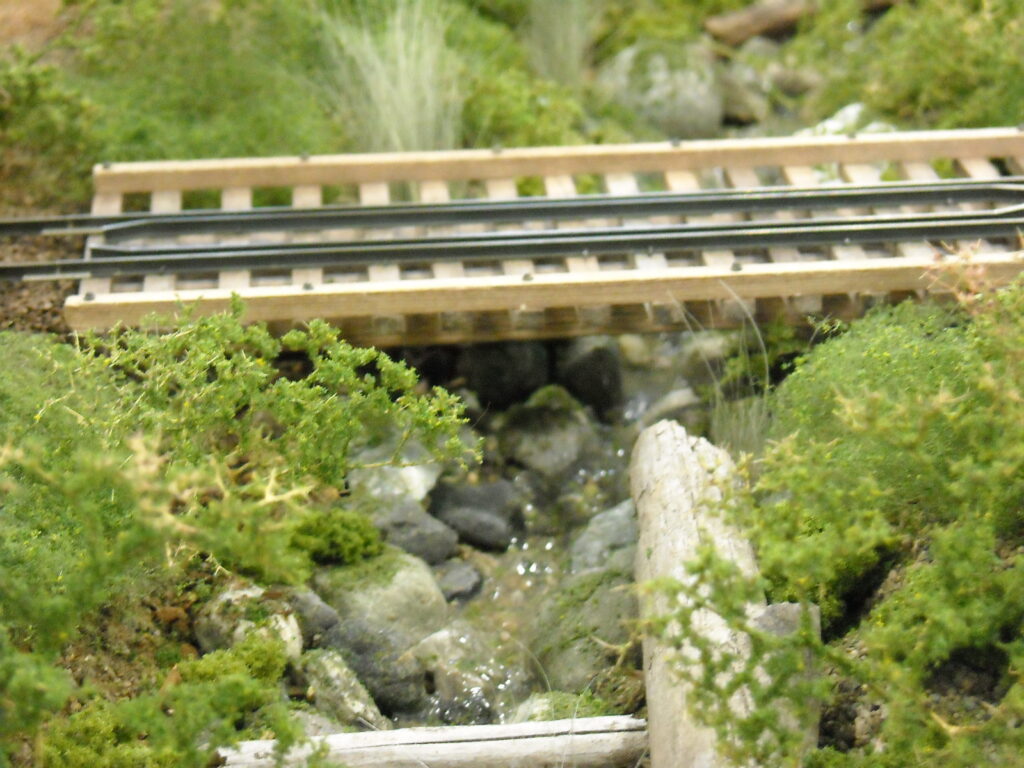Everything on model trains, model railroads, model railways, locomotives, model train layouts, scenery, wiring, DCC and more. Enjoy the world's best hobby... model railroading!
From Simple Oval to Dream Layout: Smart Model Railroad Planning Tips for a More Realistic Track Design
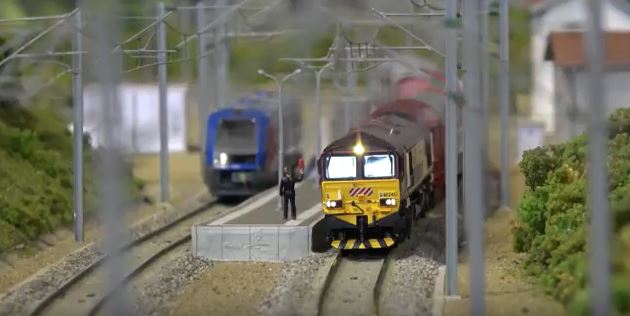
There comes a point in every model railroader’s journey when watching trains circle endlessly around an oval just isn’t enough anymore. At first, a basic loop is perfect… it’s affordable, easy to build, and a great way to learn the fundamentals. But sooner or later, inspiration strikes. Maybe it was a magazine article, a YouTube video, or a stunning layout you saw at a model train exhibition. Suddenly, you’re no longer content with a “toy train” setup. You want something more realistic, more engaging, and far more rewarding to operate.
That moment marks the shift from casual train owner to serious model railroader.
However, starting your first real model railroad layout is also where many people run into trouble. The planning stage is the most critical part of the entire project, yet it’s often rushed or underestimated. Decisions made early… especially about track configuration and space usage… can have long-lasting effects on how realistic your layout looks and how enjoyable it is to operate.
Why Early Layout Planning Matters So Much
Mistakes made during construction can often be fixed later. Scenery can be reworked, buildings moved, and details refined as your skills improve. Track planning errors, however, are much harder to correct once rails are laid, wiring is installed, and scenery is built around them.
Poor planning can lead to tight curves, awkward track flow, limited train operations, and constant derailments. Even worse, it can leave you with a layout that simply isn’t fun to run. That’s why careful thought at the beginning can save enormous amounts of time, money, and frustration later.
Progress Is Good — Rebuilding Isn’t Always
There’s a big difference between improving a layout and rebuilding one from scratch. Most model railroaders continuously upgrade their railroads as they learn new techniques. That’s a healthy and enjoyable part of the hobby.
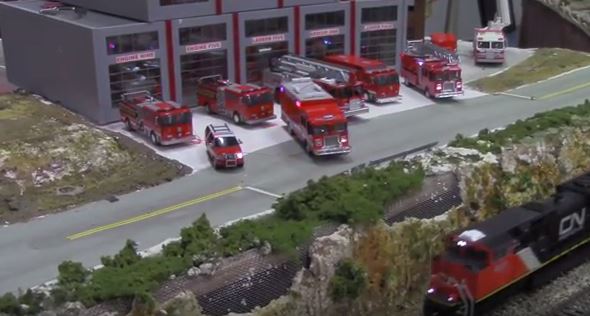
The problem arises when a layout must be torn apart because the original design doesn’t work operationally. If trains can’t pass each other smoothly, sidings are too short, or the track plan feels cramped and unrealistic, enthusiasm quickly fades. Good planning helps ensure your layout can grow and evolve rather than needing major surgery.
Think Beyond the Track Plan
Many beginners focus heavily on choosing a track plan without first considering whether it makes sense for their space, goals, and operating style. While track plans are helpful, they’re not a magic solution.
Before committing to any design, ask yourself some important questions:
- How much space do I really have?
- Do I want continuous running, switching operations, or both?
- Am I more interested in scenery or train movement?
- Will I be running long trains or short locals?
- Do I want future expansion options?
Answering these questions helps define what kind of layout will actually work for you… not just what looks good on paper.
Track Planning Is a Skill You Develop Over Time
Track planning isn’t something most people master instantly. It’s an acquired skill that improves with experience, observation, and learning from others. One of the smartest things you can do is study layouts that work well… and also learn from layouts that don’t.
See these useful Model Railroading E-book Best Buys
There’s no need to repeat common mistakes that countless model railroaders have already made. Tight curves everywhere, too few sidings, unreachable track sections, and unrealistic track arrangements are all avoidable with a little forethought. If you do make mistakes, try to make new ones… at least you’ll learn something valuable.
Design for Realism and Operation
A well-planned model railroad should look believable and operate smoothly. Track should flow naturally through the scene, trains should have places to meet and pass, and the layout should feel purposeful rather than random. This doesn’t mean complicated… it means thoughtful.
Even modest layouts can feel expansive and realistic when the space is used wisely. Smart planning allows you to get the most enjoyment from the room you have, rather than constantly wishing for more space.
Summing Up
Moving beyond a simple oval is an exciting step in the model railroading hobby. It’s where creativity, problem-solving, and long-term enjoyment really begin. Take your time, think logically, and plan with intention. The more care you put into the early stages, the more satisfying… and successful… your model railroad will be.
A well-planned layout doesn’t just run better… it keeps you motivated, inspired, and enjoying the hobby for years to come.
Model Railroad Layout Planning Made Easy: How to Design Around What You Enjoy Most
Designing your ideal model railroad layout becomes much simpler once you’re clear about what truly excites you about the hobby. Some model railroaders are passionate about building highly realistic scenery, while others get their enjoyment from yard switching, long mainline runs, or creating intricate track plans. None of these approaches are “better” than the others… it all comes down to personal preference.
The real challenge is that most of us are working with limited space. Every decision you make affects something else. More track usually means less room for scenery. More switching yards can reduce space for long scenic runs. That’s why understanding your priorities before you start building is so important.
One effective way to do this is by using simple visual planning tools that help clarify what matters most to you. In this case, two free “sliding cursor” diagrams can make a big difference. These tools shown in this video allow you to compare key layout elements and find the right balance for your space and interests.
The first diagram in this video focuses on scenic realism versus track and operations. Sliding the cursor toward one end emphasizes scenery… mountains, towns, and detailed landscapes. Moving it in the opposite direction favors more track, yards, and operational complexity. Seeing this balance visually helps you decide how much space to allocate to each element.
The second video diagram looks at operating style. Do you prefer hands-on switching with frequent train movements and problem-solving? Or do you enjoy watching trains roll smoothly along a mainline for extended runs? Placing the cursor where you feel most comfortable helps define how your layout should function day to day.
This simple exercise doesn’t take long, but it can save you a great deal of frustration later. By clarifying your priorities early, you’re far less likely to redesign sections of your layout or feel disappointed once construction is underway.
Thoughtful planning keeps your layout focused on what you enjoy most… and that’s what makes the hobby truly rewarding. When you build with purpose and clarity, the entire process becomes more enjoyable, more efficient, and far more satisfying.
Facebook / modeltrainsrailroads
Model Railroad Track Planning Tips: Using Sidings for Smooth, Realistic Train Operations
Start With Planning Your Trackwork
Good model railroad trackwork is about far more than laying track neatly on the layout base. Smart track planning plays a huge role in how smoothly your trains operate… especially once you start running more than one train. Without proper planning, even a great-looking layout can suffer from delays, constant stopping, and frustrating operating problems.
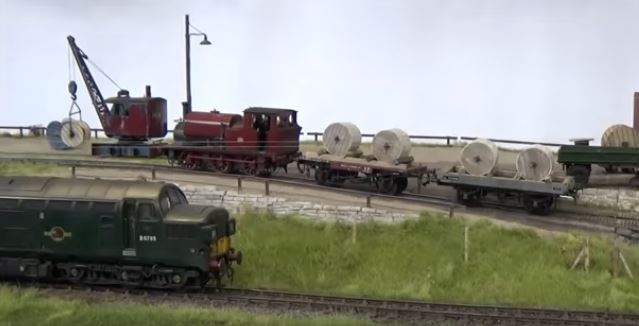
Bentley Model Railway Groups TrainWest Show at Corsham
When only a single train is running, most layouts perform reasonably well. The moment you introduce a second or third train, however, poor track design quickly becomes obvious. Trains may be forced to stop and wait, passings become awkward, and the overall flow of rail traffic slows dramatically. This is where passing sidings become essential.
Add Sidings
Adding multiple sidings is one of the most effective ways to improve model railroad operations. With three or more well-placed sidings, trains can meet and pass each other smoothly, allowing continuous movement rather than frequent stops. One train can pull into a siding while another passes, keeping operations fluid and realistic.
Layouts with only two sidings can still function, but operations tend to feel rushed. Trains must move quickly between sidings to avoid delays, which often leads to unrealistic running speeds and reduced enjoyment. With just a single siding, operations become very limited… one train must wait while the other completes its run, making multi-train operation impractical.
Siding length is just as important as siding quantity. Each siding must be long enough to hold the longest train you plan to run. A siding that cannot accommodate even your shortest train offers little operational value. Before laying track, measure your typical train lengths and design sidings accordingly. Longer sidings provide greater flexibility and reduce operating stress.
Space limitations will always influence track design, but even small layouts benefit from thoughtful siding placement. Strategic use of sidings can dramatically improve operational realism without adding excessive complexity.
In short, effective model railroad track planning focuses on how trains move, meet, and pass… not just how the track looks. By incorporating enough properly sized sidings, you’ll enjoy smoother operations, fewer bottlenecks, and a layout that feels far more like a real railroad.
Creative Model Railroad Ideas: How to Use HO Scale, OO, and N Scale Shipping Containers for Realistic Scenes
Shipping containers might be small, but on a model railroad they can do some seriously heavy lifting. Whether you model in HO scale, OO gauge, or N scale, containers are among the most flexible scenic items you can add to a layout. They instantly suggest modern freight activity, add visual mass without clutter, and help tell a believable story… even in tight spaces.
If you already have a few containers tucked away, or you’re considering adding them, here are several smart and practical ways to make them work harder on your model railroad.
- Add Instant Purpose with an Intermodal Yard
An intermodal yard is the most natural home for shipping containers. A short siding with a small stack of containers immediately explains why trains stop there. You don’t need a huge yard either… just stacking containers two or three high near a crane, forklift, or reach stacker creates the impression of a busy freight hub. Even a compact scene can feel active and modern with the right container placement.
You can download all 40 scale model shipping container plans at
https://www.modelbuildings.org/shipping-containers
- Repurpose Containers into Buildings
In the real world, containers are often converted into offices, workshops, cafés, storage sheds, and site huts. The same idea works beautifully on a layout. By adding doors, windows, signage, or rooftop details, you can turn a container into a temporary site office or urban pop-up business. This is a great way to add unique structures without needing full-size buildings.
- Use Containers as Scenic Breaks and View Blockers
Shipping containers are excellent at solving awkward layout transitions. Stacks of containers placed along a road, fence line, or track can hide backdrop seams, mask tight curves, or visually separate scenes. Because containers naturally appear in rows or clusters, they don’t look like “fillers”… they look intentional.
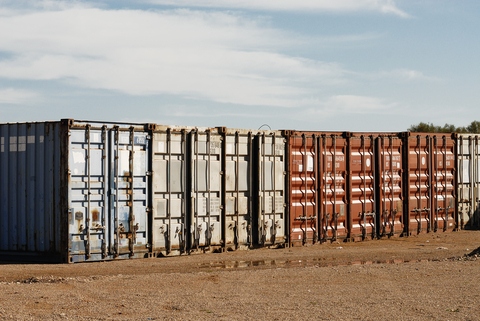
- Create a Container Storage Yard
A fenced container lot adds texture and storytelling to an industrial area. Containers can be arranged neatly in rows or scattered slightly out of alignment for a more weathered, hard-working look. Add weeds, oil stains, puddles, pallets, and discarded junk, and the scene quickly feels lived-in and believable.
- Load Containers onto Trains and Trucks
Containers shine when they’re actually doing their job—moving freight. Loading them onto flatcars, spine cars, or well cars instantly adds realism to your rolling stock. They also look great on truck trailers or parked on chassis, reinforcing the connection between rail and road transport.
- Strengthen Harbor and Dock Scenes
If your layout includes a port, dock, or waterfront industry, containers are almost essential. Even a small wharf scene benefits from a few containers scattered near cranes or stacked beside a pier. They visually explain cargo movement and help make the area feel busy without needing a large footprint.
- Add Realism Through Weathering
Brand-new containers have their place, but weathering brings them to life. Rust streaks, faded paint, dents, scratches, and graffiti make containers look used and authentic. Mixing clean containers with heavily weathered ones adds contrast and realism—just like the real world.
- Enhance Scale and Visual Balance
Containers are excellent scale references. On smaller layouts, a handful of containers can suggest a much larger operation just beyond the modeled area. On larger layouts, they fill space naturally without overpowering the scene. Regardless of scale, they help ground your layout visually.
In a nutshell…
Shipping containers are far more than simple freight loads. They’re compact, adaptable, and incredibly effective at adding realism, structure, and story to a model railroad. Whether they’re stacked in a yard, converted into buildings, or rolling past on a train, containers bring modern railroading to life with very little effort.
If you enjoy hands-on modeling, you can even construct highly detailed, photo-realistic scale shipping containers featuring rust, dents, refrigeration units, locking bars, and authentic company logos. With downloadable designs, you can build multiple containers of each type and populate your layout with dozens of realistic variations—perfect for trains, yards, and industrial scenes alike.
How to Plan Realistic Model Railroad Scenery: A Practical Guide for Beginners
Planning your first model railway layout can feel intimidating. There’s a lot to learn, countless choices to make, and plenty of opportunities to get things wrong. If it helps, even long-time model railroaders still make mistakes from time to time. The key difference is that experience teaches you which mistakes are hardest to fix later. With careful planning and a clear approach to scenery, you can avoid many common problems and create a layout that looks natural, balanced, and enjoyable to operate.
One of the most effective ways to improve the appearance of any model railroad is by introducing variation in scenery height. Flat layouts tend to look toy-like and predictable. Even modest changes in elevation… such as a slightly raised mainline, a shallow cutting, or a lower siding… add visual interest and help the scene feel more like the real world. However, elevation changes must be believable. Track should never appear to float above the surrounding terrain without explanation.
Whenever you raise a section of track, think about how it would exist in real life. Does it need a grassy embankment, a small cliff face, or a retaining wall? Would erosion, rock outcrops, or drainage ditches be visible? These scenic elements help justify the height difference and allow the track to “flow” naturally through the landscape. Taking the time to plan these transitions early is important because correcting unrealistic elevation later can be very difficult once track and wiring are complete.
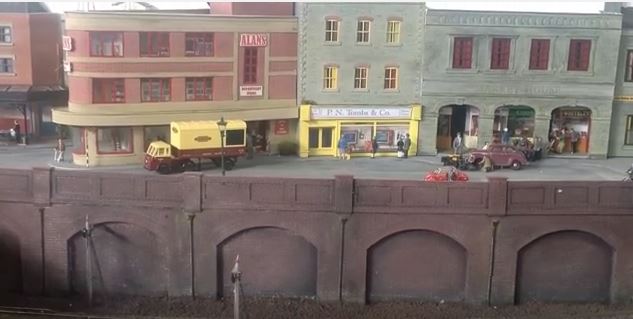
Another essential consideration is consistency of theme. Decide early on what era, region, and general setting your layout represents. While it can be tempting to mix different locations, seasons, or time periods, doing so on a small or medium-sized layout often results in visual confusion. A desert scene next to a lush mountain forest, or modern rolling stock passing a 1950s town, can quickly break the illusion.
If you want variety, use scenic dividers, tunnels, view blocks, or gradual transitions to separate scenes. On larger layouts, these techniques allow you to represent different areas without them clashing visually. On smaller layouts, sticking to a single, well-defined theme usually produces better results and a more convincing overall appearance.
Impulse buying is another common trap. Most hobbyists have brought home a structure, vehicle, or scenic item simply because it looked great on the store shelf. Before adding anything new, pause and ask a few questions. Does it fit the era? Does it belong in this location? Does it add to the story your layout is telling, or does it simply add clutter? Thoughtful restraint often leads to cleaner, more realistic scenes where individual details can be appreciated.
When it comes to building scenery itself, a handful of proven techniques can dramatically improve realism. Start with layered ground cover. Use earth-toned base colors, then add gravel, ballast, dirt, and ground foam in multiple shades. Nature is rarely uniform, so variation in color and texture is essential. Layering materials creates depth and avoids the flat, artificial look of a single surface texture.
Water features are another powerful scenic element when done well. Rivers, creeks, ponds, or drainage ditches can add movement and interest to a layout. Use clear resin or acrylic water products, but don’t neglect the surrounding area. Realistic water scenes depend heavily on textured banks, muddy edges, rocks, and vegetation to sell the effect.
Trees and shrubs also play a major role in defining a scene. Use scale-appropriate sizes and shapes that match your chosen region. Forest edges should look irregular, not like a straight line of identical trees. Mixing tree heights, colors, and densities creates a more natural appearance.
Roads and streets deserve careful attention too. Whether paved or dirt, roads should show signs of use. Slight cracks, faded paint, tire wear, and weathering powders help integrate them into the scene rather than making them look freshly installed. Adding details such as signs, fences, and roadside vegetation further enhances realism.
Weathering ties everything together. Buildings, rolling stock, and even scenery benefit from subtle aging. Dust, rust streaks, grime, and faded paint help models blend into their environment instead of standing out unnaturally.
Lighting is the final layer that can truly bring a layout to life. Soft building lights, streetlamps, and illuminated structures create atmosphere and draw viewers into the scene, especially during evening operations.
Above all, slow down and plan carefully. Many scenery mistakes can be avoided simply by thinking things through before committing glue or paint. Model railroading is a long-term hobby, and learning never really stops. With patience, observation, and thoughtful planning, your layout can evolve into a realistic miniature world that you’ll enjoy for years to come.
Follow us on FACEBOOK https://www.facebook.com/modeltrainsrailroads
Using a Small Mirror to Improve Model Railroad Track Alignment and Reliability
A small mirror tile is an inexpensive but surprisingly powerful tool every model railroader should keep close at hand. While it may seem simple, a mirror can help you spot track problems that are often hard to see with the naked eye, especially once the layout is built and access becomes limited.
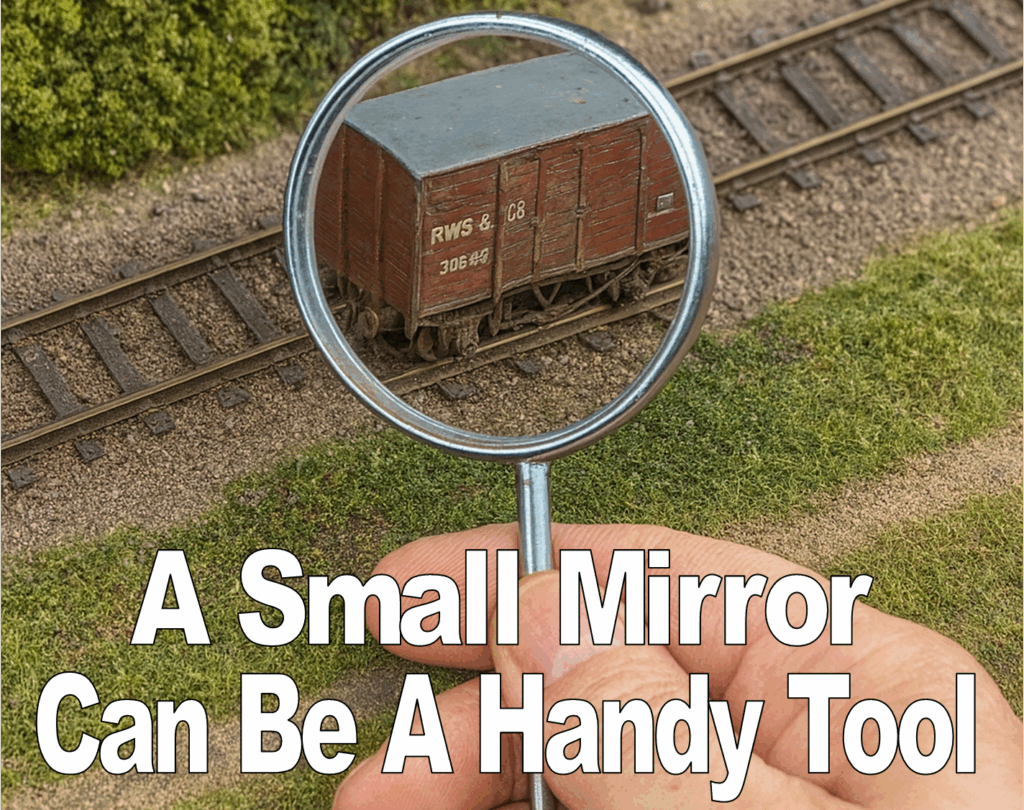
One of the best uses for a mirror is checking track alignment. By standing a small mirror on its edge directly on the track, you can examine the rails by looking at their reflection rather than trying to sight along them at track level. This reflected view exaggerates imperfections, making subtle kinks, dips, and uneven joints far easier-to-detect. Issues that look smooth when viewed normally often stand out clearly when seen in a mirror.
This technique also saves wear and tear on your body. Constantly bending down to rail height can be uncomfortable, especially during longer track-laying sessions. Using a mirror lets you inspect alignment while standing or sitting comfortably… no crouching, stretching, or accidental track marks on your face.
A mirror is also extremely useful when troubleshooting derailments. Placed alongside the track, it allows you to watch wheels, trucks, and couplers as a train moves through a problem area. You can quickly see whether wheels are lifting, binding, or tracking poorly through turnouts or curves.
Mirrors are especially valuable in hard-to-reach locations such as tunnels, behind scenery, or near layout edges. However, they are just as effective on open track during initial installation. Catching alignment issues early will save time and frustration later.
Simple, cheap, and effective, a small mirror can significantly improve track quality, reliability, and smooth train operation on any model railroad.
Turnout Placement Tips for Reliable and Realistic Model Railroad Trackwork
When planning a model railroad layout, turnout location plays a major role in how smoothly your trains run and how realistic your trackwork looks. Poorly placed turnouts can lead to derailments, awkward train movements, and track that simply doesn’t look right. Taking the time to plan ahead will save frustration later.
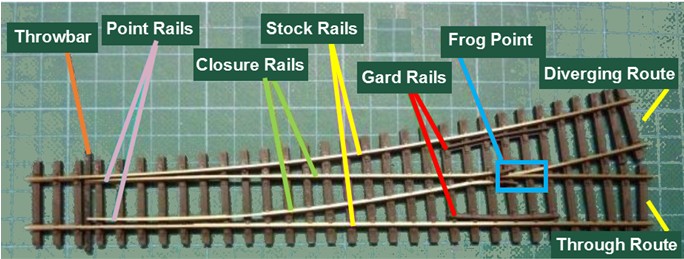
Before laying any track, sketch your full track plan on paper or using layout design software. Clearly mark where each turnout will go and how it connects to both straight and curved track sections. This makes it easier to check alignment and avoid last-minute adjustments that can compromise reliability.
Whenever possible, place your mainline on the straight leg of a turnout, just as real railroads do. Running mainline traffic through the curved leg increases side forces on wheels and couplers, which can cause problems… especially with longer rolling stock. Keeping the mainline straight through turnouts improves both operation and appearance.
Be especially careful to avoid tight S-curves created by turnouts placed too close together or connected directly to opposing curves. Adding short straight sections between curves helps trains transition smoothly and reduces derailments.
Also consider turnout length. Larger, longer turnouts may require extra space but provide gentler curves and better performance. Finally, don’t forget the space needed beneath or beside the turnout for switch machines or manual throw mechanisms. Planning for these details early ensures smooth, dependable operation and a layout that looks right from every angle.
How Steep Should You Make Your Model Train Track? A Guide to Avoiding Derailments, Motor Burnout, and Traction Issues
One of the most common questions among model railroad enthusiasts is: How steep should I make the slope of my track? This concern usually stems from potential issues like derailments, motor burnout, and poor wheel traction. To help you strike the perfect balance between functionality and performance, let’s break down the key factors involved in determining the ideal track gradient.

The 3% Rule of Thumb
As a general rule, you should aim for no more than a 3% slope. This means for every 100 inches of track, you would have a 3-inch rise in elevation. At this slope, you are unlikely to encounter significant issues, such as derailments or overloading the motor.

To put it into perspective, a 3% grade translates to a rise of approximately 3/4 inch for every 2 feet of track. If you can maintain this grade, your trains should run smoothly under typical conditions.
Can You Go Steeper?
If you’re running shorter trains, you might be able to push the grade slightly steeper without causing issues. However, there’s a trade-off. The steeper the slope, the harder the locomotive has to work to pull the train, which can result in motor burnout. Traction tires can help with this, allowing you to tackle steeper grades with longer trains. But, be mindful that the motor still has to work harder, and overloading it could lead to premature failure.
Shorter Grades for Shorter Runs
Another option is to use shorter grades. In cases where only part of the train is on the incline at any given time, you can increase the grade slightly. For example, if you’re planning a short climb, the entire length of the train may never be affected by the steep slope. This can provide a more forgiving experience, as the locomotive won’t have to work as hard over longer distances.
The Best Approach: Gentle Slopes
If you want your trains to run with minimal issues and the longest possible run, it’s always best to opt for the most gradual incline possible. Keeping the grade gentle reduces the strain on your motor, ensures better wheel traction, and generally improves the reliability of your layout.
A Note on Curves
If the incline also includes a curve, it’s essential to make the grade even less steep. Curves add additional drag to the train, and a steeper grade on a curve can increase the chances of derailments and motor strain. To prevent these problems, keep your curves as gentle as possible when adding elevation changes.
Conclusion
In summary, when designing your model train layout, a 3% slope is generally the sweet spot. It offers a good balance between performance and motor safety. If you’re planning to go steeper, ensure you’re running shorter trains or using traction tires to help with traction. And remember, when your track includes curves, reduce the grade to minimize drag and prevent derailments. By keeping these factors in mind, you can enjoy smooth, reliable train operation while avoiding common problems like motor burnout or derailments.
Grab a Bargain on these Model Train E-books – Available now at the lowest prices ever offered!

The BEGINNERS BLUEPRINT Model Railroading PDF e-book series is your ultimate guide to building a model railroad, whether you’re just starting out or looking to improve your skills. Here’s what you’ll find in this comprehensive 6-part series:
- Planning Basics
Learn the fundamentals of model railroading with this e-book. It explains key terms like scales and gauges, helps you avoid common planning mistakes, and shows you how to start small and expand as you gain experience. You’ll also get an overview of DC vs. DCC power systems and a step-by-step guide to planning your ideal layout. - Track & Benchwork Basics
This guide covers everything from choosing the right track to building solid benchwork. Learn how to create modular layouts, prevent common track-laying mistakes, and get tips on ballasting, working out gradients, and wiring your layout with easy-to-follow diagrams. - Scenery Basics
Master the art of creating realistic scenery, including trees, roads, tunnels, and more. With clear instructions and visuals, this e-book makes it easy to craft detailed backdrops, weathered buildings, and stunning landscapes. - DCC Basics
DCC (Digital Command Control) doesn’t have to be intimidating. This e-book explains how to get started with DCC systems, covering everything from wiring to throttle control, with diagrams to guide you. - Troubleshooting
When something goes wrong, this guide helps you quickly identify and fix problems—saving you time and frustration. - 138 Questions & Answers
This handy reference is packed with expert solutions to common problems, helping you resolve issues quickly and efficiently.
Each downloadable e-book is simple to understand, with step-by-step instructions and helpful visuals. Save time, money, and frustration with these proven techniques!
Railroad Inventory Data
Nelson writes:
“My daughter suggested an Excel Spreadsheet as the best way to keep a record of my trains: model type and number, date purchased, working condition, wheels, length, DCC, maintenance history, purchase price etc. She has offered to set it up for me and teach me how to use the software. It could be handy, but will the effort outweigh the benefit? What have others found? Thank you in advance.”
Mastering Realistic Layouts: How to Use Colors and Textures for Authenticity in Model Making
Colors and Textures: The Key to Realistic Layouts
When it comes to creating a realistic model layout, colors and textures play an essential role in bringing your scene to life. Realism is all about mimicking the colors and textures of the real world. By paying close attention to these details, you can add depth and authenticity to your creations.
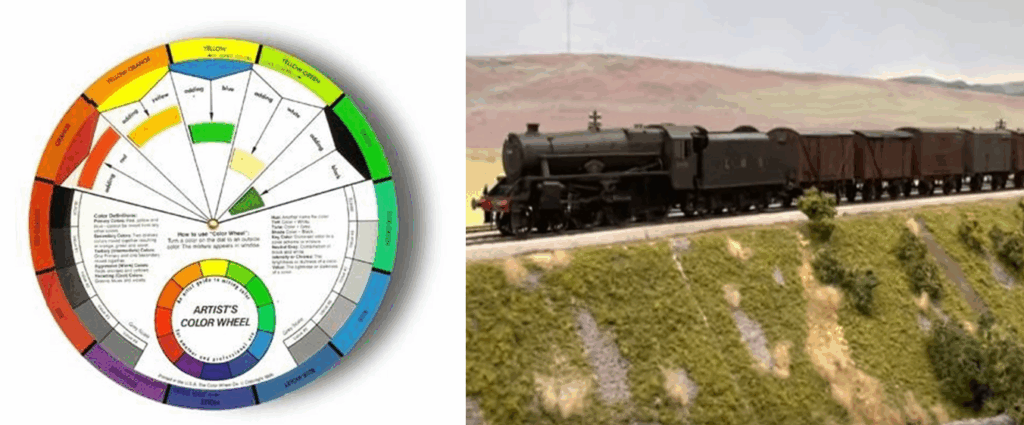
By thoughtfully applying colors and textures, you’ll create layouts that feel authentic, whether you’re building a rustic landscape, a city scene, or a wintry wonderland.
Acrylic paints are your best friend in this process. These water-based paints are not only easy to work with but can also be thinned to the perfect consistency for different techniques. The added bonus? Cleaning up is a breeze. Unlike oil paints that require solvents like mineral turpentine, acrylics can be cleaned with plain water, making them much more convenient for brush and airbrush users.
To achieve a truly natural look, experiment with various colors and textures. Play around with different patterns and arrangements to simulate real-world wear and tear, such as weathering effects. This helps make your layout feel like it’s been through the test of time.
When selecting colors, aim for natural hues that reflect real-world environments. Greens, browns, and grays should be your primary palette, as these shades are commonly found in nature. If you’re working on a winter scene, white can be added for snow effects. White also works well as a base for mixing lighter shades, which is helpful for creating highlights and softer transitions.
Bachmann EMD E7 Vs Proto 2000 E7
Steve asks:
“How does an HO Bachmann EMD E7 compare with a Proto 2000 E7 – reliability, faults, shell detailing, etc?”
You can post your comments below.
Transform Your Scenery: Using Color and Texture for Hyper-Realistic Model Railroads
Creating a layout that feels like a real miniature world—rather than a toy train set—often comes down to two essential ingredients: color and texture. These elements shape how the eye interprets a scene, and when used well, they can completely change the atmosphere and realism of your railroad..
Whether you’re building rolling hills, desert plains, industrial grime, or lush forest, mastering colors and textures is one of the easiest ways to elevate your layout from “nice” to “wow!”
6 Ways to Use Color & Texture for More Natural, Realistic Scenery
1. Break Free From “One-Green-Fits-All”
Real landscapes come in dozens of greens… yours should too.
One of the quickest giveaways of an unrealistic layout is using the same green everywhere. Nature simply doesn’t do that. Grass near a ditch looks different from sun-bleached grass near a road. Young shrubs are bright, fresh green, while older growth looks deeper and more muted.
Try blending a variety of shades:
- olive and sage greens
- brown-green mixes
- fresh yellow-greens
- darker forest greens
Sprinkling in touches of tan or brown also gives the illusion of patchy, irregular growth. The result? A landscape that feels alive instead of plastic.
2. Build Up Texture in Layers
Flat surfaces scream “fake.” Layering creates depth.
In the real world, nothing is perfectly smooth… not fields, not dirt roads, not forest floors. To recreate that natural roughness, build your scenery using layers of texture.
Start with:
- a dirt-colored base coat
- a thin layer of fine ground foam
Then add: - static grass
- coarse scatter
- small stones
- weeds, tufts, bushes, sticks
Every pass adds more dimension. Layer by layer, your flat plywood turns into terrain with contour, depth, and life.
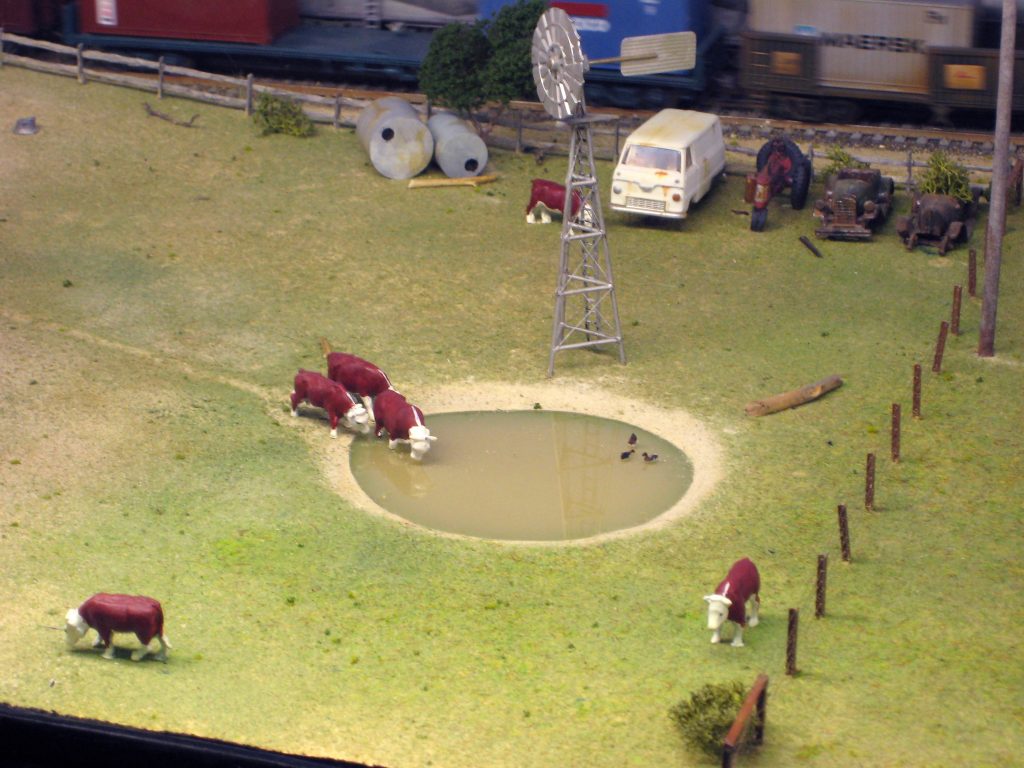
? Download the latest Model Buildings catalog FREE here:
https://www.modelbuildings.org ?
3. Weather More Than Just Your Rolling Stock
Everything ages… make sure your scenery does too.
Weathering isn’t limited to locomotives and freight cars. Trackside structures, roads, bridges, and even the ground around them all show signs of age.
A few ideas:
- Faded paint on buildings
- Mossy green tints near wet areas
- Dusty, darkened paths where foot traffic occurs
- Oil streaks around engine facilities
- Rust stains below metal fittings
A little grime goes a long way. When everything blends with age, the whole scene becomes more cohesive and convincing.
4. Stick With Earthy, Natural Color Palettes
Bright colors should be accents, not the backdrop.
Real terrain rarely features bright, saturated color. Instead, it’s dominated by earth tones… soft browns, sandy tans, muted greens, stone grays.
Use these tones as your foundation. Then add brighter pops of color only where needed:
- signage
- flowers
- vehicle lights
- clothing on figures
When flashy colors are used thoughtfully, they draw attention without overwhelming the scene.
5. Match Textures to the Terrain You’re Creating
Different environments need different materials.
Not all textures are interchangeable. Gravel should look like gravel. Dirt roads should feel dusty and worn. Rocky cuts should feel sharp and irregular.
Try these texturing ideas:
- Fine sandpaper makes convincing compacted dirt
- Sifted real soil glued down looks great in rural areas
- Bark chips or crushed leaves work for forest floors
- Carved foam, plaster, or small real stones create crags and cliffs
When each type of terrain has its own distinct surface, the viewer’s eye recognizes it immediately… boosting realism without explanation.
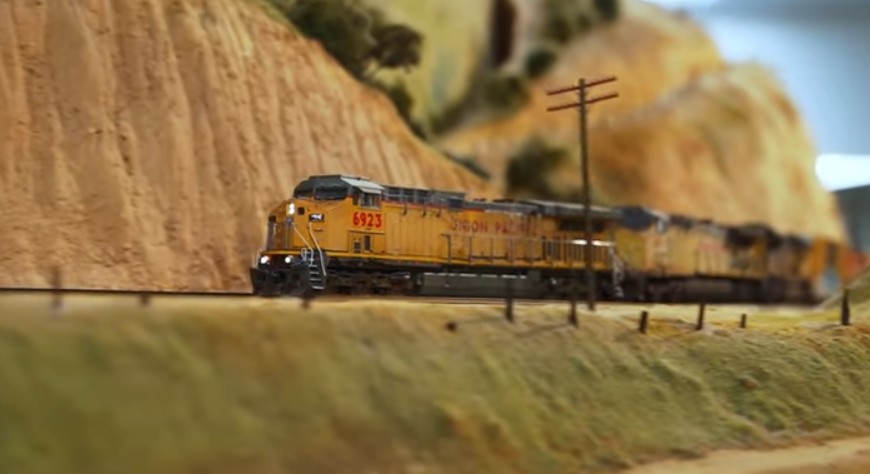
6. Learn From the Real Outdoors
Nature is the best reference guide you’ll ever have.
One of the simplest ways to improve your scenery is to observe the real thing. Spend a few minutes photographing roadside grass, the color of gravel, or the way dirt collects at the base of fences.
Look closely at:
- how many browns are in a patch of earth
- how shadows change color perception
- how messy, uneven, and imperfect everything is
You’ll start noticing details you never thought to include before, and those details will set your layout apart.
Create Scenes That Feel Alive
Your model railroad doesn’t need to be flawless to be believable… it just needs to capture the essence of the real world. With thoughtful use of color variation, textured layering, and a bit of natural inspiration, you can create scenery that feels rich, organic, and truly immersive. Let your imagination and the real outdoors guide you, and watch your miniature world come alive.
Identifying A Cracked Gear
Don models HO and asks:
“My GP9 has started to make a funny noise. Could this be the telltale signs of a broken or crack gear?”
If you would like to add suggestions, you can do so using the “COMMENTS” link blow.
Getting S Curves Right for Smooth Model Train Running
Let’s chat about S curves… those graceful back-and-forth bends that make a model railroad look alive and dynamic. They add flow, variety, and a natural look to your scenery. But while they’re beautiful to watch, S curves can quietly become one of the biggest trouble spots on a layout if they’re not designed with care.
Many modelers (me included) have discovered the hard way that poorly planned S curves can mean derailments, wobbly couplers, and general frustration. The secret isn’t avoiding them altogether… it’s understanding how to design them so they run smoothly and reliably.
What Is an S Curve, Exactly?
An S curve happens whenever the track curves one direction and then immediately swings the opposite way. Picture the shape of the letter “S.” You’ll find them in scenic areas, industrial sidings, and yard ladders… basically anywhere the track changes direction quickly.
The problem shows up when longer cars or locomotives enter the curve. That quick change in direction forces the couplers to twist in opposite ways, putting a lot of sideways pressure on both trucks.
Why They Can Be Tricky
A single curve is no problem; every car just follows the same arc. But when a left-hand curve rolls straight into a right-hand one, the cars at the joint are pulling against each other. The longer the cars, the more severe the stress. That’s why modern passenger cars and long freight stock are most likely to misbehave on tight S curves. Short 40-foot boxcars and switchers tend to glide through with much less drama.
Add a Straight in Between
One of the simplest fixes is to insert a short straight section between the two opposing curves. Even a single car length of straight track can “reset” the couplers, letting everything line up again before hitting the next bend. Without that straight, you create what’s known as a pinch point… and that’s where derailments and uncoupling love to happen.
Go Big When You Can
Radius size makes a huge difference. Tight curves magnify every flaw, while broad curves let trains flow naturally. In HO scale, for example, 24-inch curves handle long cars far better than 18-inch ones. If you’ve got the room, always go wider… especially where two curves meet.
Check Turnouts and Yards
S curves often sneak into yard ladders or crossover areas. Placing two turnouts back-to-back without any straight in between creates the same side-to-side tension as a regular S curve. Adding even half a car length of straight track can dramatically improve reliability.
Five Handy Tips
- Use broad curves wherever space allows
- Insert a straight between opposing bends
- Avoid S curves directly after switches
- Test with your longest cars before finalizing
- Slow down through tight trackwork
Handled thoughtfully, S curves look amazing and run smoothly. A little extra planning now means fewer derailments later… and trains that glide through those bends just the way they should.
Keep Your Trains on Track: Why Model Train Derailments Happen (and How to Stop Them)
Few things are more frustrating for a model railroader than watching a beautifully detailed train take a nosedive off the track. Whether it’s one stubborn car that always jumps the rails or an entire consist that suddenly derails, the result is the same… damaged stock, chipped scenery, and a few choice words muttered under your breath.
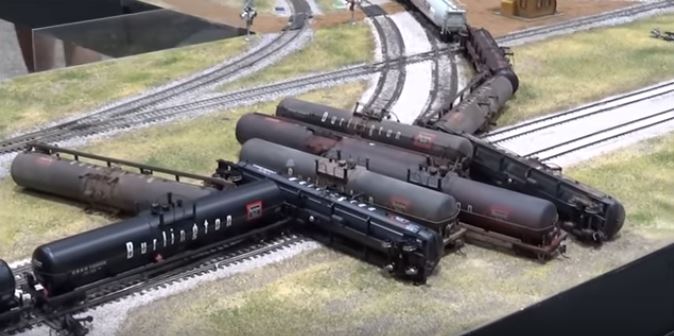
Derailments can be caused by anything from a dirty wheel to a misaligned turnout, and figuring out the culprit can feel like detective work. Sometimes the problem is limited to one tricky spot on the layout. Other times, derailments happen all over, pointing to issues with the locomotive or rolling stock – things like wheel alignment, trucks, couplers, or even uneven weighting.
If derailments keep happening in the same place, though, it’s a pretty good sign there’s a local track issue… a kink in a rail join, a warped section of track, a misaligned switch, or a slope that’s just a bit too steep.
Luckily, most derailments are easy to fix once you know what to look for. Here are some common causes, and how to keep your trains running smoothly.
Tips to Prevent Model Train Derailments
- Keep your track and rolling stock clean.
Dust, grime, and oxidation can build up fast and cause wheels to lift or slip. Regular cleaning keeps everything running silky smooth. - Clean your electrical connections and controls.
Poor conductivity can make trains jerk or stall, which sometimes leads to derailments. - Do regular preventative maintenance.
A few minutes of upkeep now saves hours of troubleshooting later. - Lubricate wheels and couplers… but sparingly.
A dry coupler can snag or jerk; too much oil attracts dust and can damage paintwork. Less is more! - Check the weight of your cars and wagons.
Cars that are too light can bounce or tilt on curves, especially tight ones. - Add a little extra weight when needed.
Just a few extra grams, placed low and centered, can improve traction and balance dramatically. - Aim for a low center of gravity.
Weight added near the base of a car helps it hug the rails and glide through curves without wobbling.
No one wants a train wreck on their layout, and with a bit of care and maintenance, you can keep derailments to a minimum. A clean track, well-balanced cars, and smooth couplers mean your trains will stay right where they belong — on the rails, running beautifully every time
Why OO Scale Is So Popular – And Where It Really Shines
If you’ve ever browsed model railway forums or wandered through a UK hobby shop, you’ve probably noticed how dominant OO scale is in Britain. It’s practically the national standard … and for good reason.

OO scale runs at a ratio of 1:76, which makes it slightly larger than HO scale (1:87), even though both use the same track gauge of 16.5mm. That’s where things get interesting. Technically, OO scale trains are a bit oversized for the track they run on, but most British modellers are happy to overlook that in favor of the extra detail and presence OO offers. It’s a bit like choosing a slightly larger canvas… you get more room to play with textures, weathering, and character.
Compared to N scale (1:160), OO feels positively grand. N scale is brilliant for compact layouts and long scenic runs, but it can be fiddly for those of us who like to get hands-on with detailing. OO hits a sweet spot: big enough to show off rivets and rust streaks, small enough to fit a satisfying layout in a spare room or shed.
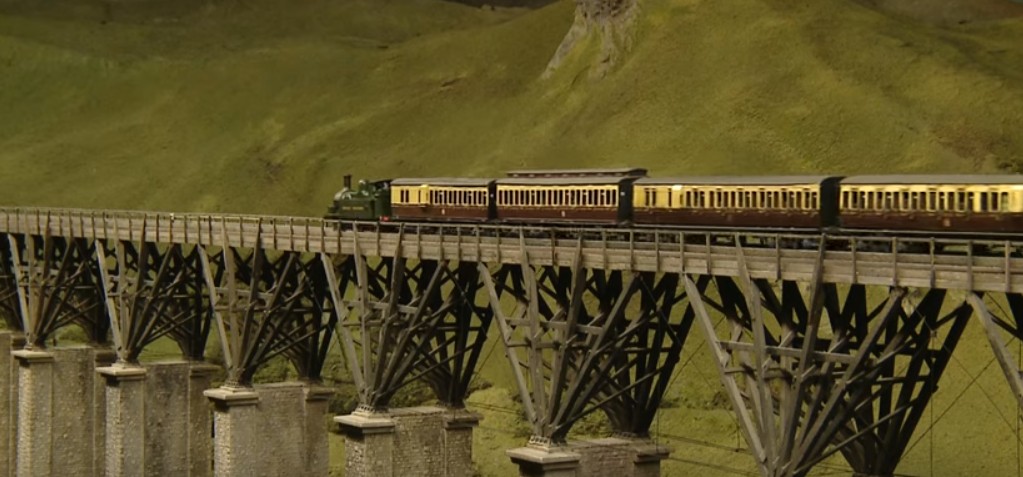
Now, where is OO scale most popular? The UK is its heartland, no doubt. Most British manufacturers… Hornby, Bachmann Branchline, Dapol… focus heavily on OO. You’ll also find pockets of OO enthusiasts in Australia and New Zealand, especially among those who grew up with Hornby sets or have a fondness for British rail history. It’s less common in North America, where HO and N dominate, but there’s still a niche following.
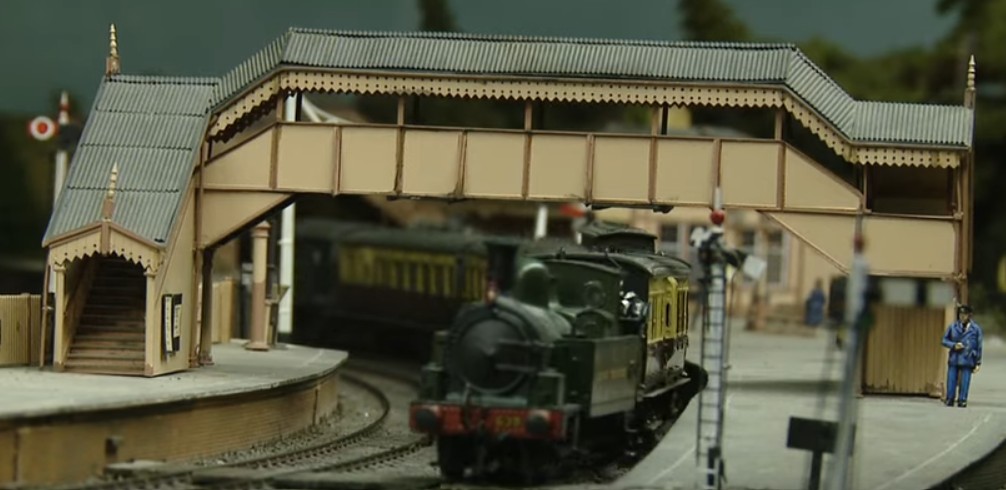
Some famous OO scale layouts are absolute jaw-droppers. Take Pendon Museum in Oxfordshire… their Vale Scene is a masterclass in rural realism, with buildings modeled from actual villages and trains running through a landscape that looks like it was plucked from the 1930s. Then there’s Great Model Railway Challenge on British TV, where teams build OO layouts under pressure… it’s a fun watch and shows just how versatile the scale can be.
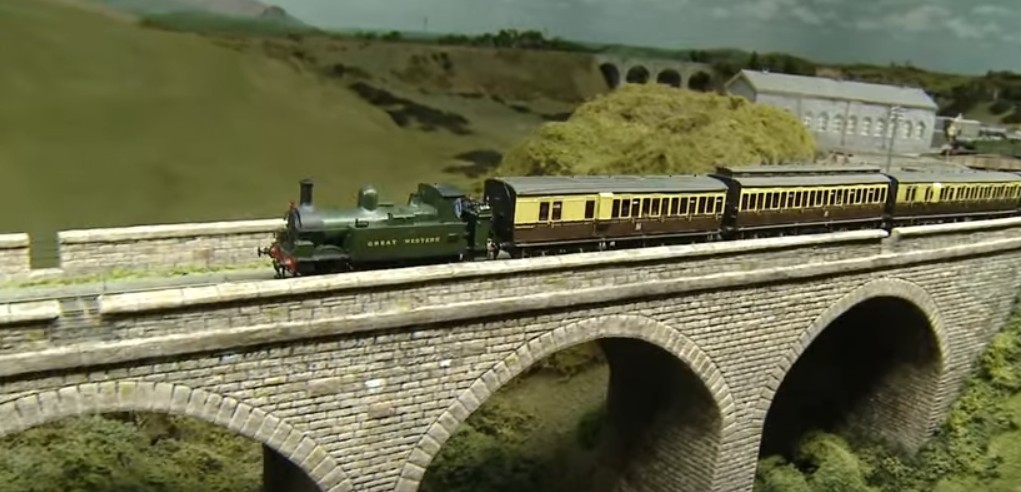
In short, OO scale is a bit of a British quirk that’s grown into a beloved standard. If you’re drawn to character-rich locomotives, charming countryside scenes, and a scale that balances detail with practicality, OO might be your perfect fit. And hey… if you’ve got a layout in OO, HO, or N, I’d love to see it. There’s always something new to learn from how others bring their miniature worlds to life.

